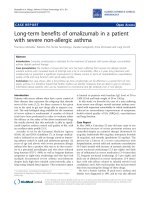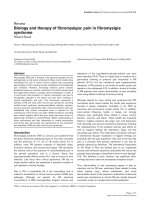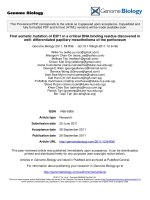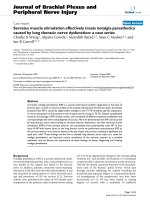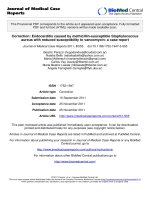Báo cáo y học: " Hydatid cyst disease of the lung as an unusual cause of massive hemoptysis: a case report" ppsx
Bạn đang xem bản rút gọn của tài liệu. Xem và tải ngay bản đầy đủ của tài liệu tại đây (403.68 KB, 3 trang )
BioMed Central
Page 1 of 3
(page number not for citation purposes)
Journal of Medical Case Reports
Open Access
Case report
Hydatid cyst disease of the lung as an unusual cause of massive
hemoptysis: a case report
Celal Tekinbas*
1
, Suleyman Turedi
2
, Abdulkadir Gunduz
2
and M
Muharrem Erol
1
Address:
1
Faculty of Medicine, Department of Thoracic Surgery, Karadeniz Technical University School of Medicine, 61080 Trabzon, Turkey and
2
Faculty of Medicine, Department of Emergency Medicine, Karadeniz Technical University School of Medicine, 61080 Trabzon, Turkey
Email: Celal Tekinbas* - ; Suleyman Turedi - ;
Abdulkadir Gunduz - ; M Muharrem Erol -
* Corresponding author
Abstract
Introduction: Echinococcosis and/or hydatidosis is one of the most important zoonotic diseases
in the world. In Turkey, echinococcosis is an endemic disease, however, hydatid disease of the lung
is uncommon and usually caused by Echinococcus granulosus.
Case presentation: In this report we describe a 17-year-old male patient who presented with
massive hemoptysis due to hydatid disease of the lung.
Conclusion: Although it is one of the less common causes of massive hemoptysis, hydatid disease
of the lung requires greater attention in countries, such as Turkey, in which hydatid cyst disease is
common.
Introduction
Echinococcosis and/or hydatidosis is one of the most
important zoonotic diseases in the world. In Turkey, echi-
nococcosis is an endemic disease and the annual inci-
dence of hydatid disease is 4.9 cases per 100,000
inhabitants [1]. However, hydatid disease of the lung is
uncommon and usually caused by Echinococcus granulosus.
In its adult stage, the parasite lives in the intestinal tract of
carnivores such as dogs and cats, as well as in herbivores
such as sheep. The head is composed of a double crown of
hook-like structures, and the body is formed by three or
four rings, the last of which bears the eggs. After being
eliminated with feces, the eggs contaminate fields, irri-
gated land and wells. Herbivores ingest the eggs, which
develop into larvae, or hydatids, within the viscera of
these animals. The cycle is completed with the ingestion
of the infected viscera by carnivores.
Humans contract the disease from water or food or by
direct contact with dogs. Once the eggs reach the stomach,
the hexacanth embryos are released. These pass through
the intestinal wall and reach the tributary veins of the liver
where they undergo a vesicular transformation and
develop into hydatids. If they overcome the hepatic obsta-
cle, they may become lodged in the lung, where they also
transform into hydatids. If they advance beyond the lung,
they may remain in any organ to which they are carried by
the bloodstream. It has been shown that the embryos can
reach the lung via the lymphatic vessels, bypassing the
liver, and there is also evidence that the disease can be
contracted through the bronchi [2].
Published: 23 January 2009
Journal of Medical Case Reports 2009, 3:21 doi:10.1186/1752-1947-3-21
Received: 13 July 2007
Accepted: 23 January 2009
This article is available from: />© 2009 Tekinbas et al; licensee BioMed Central Ltd.
This is an Open Access article distributed under the terms of the Creative Commons Attribution License ( />),
which permits unrestricted use, distribution, and reproduction in any medium, provided the original work is properly cited.
Journal of Medical Case Reports 2009, 3:21 />Page 2 of 3
(page number not for citation purposes)
Case presentation
A 17-year-old man, suffering from a cough, fever and
weight loss for the previous 5 days, was admitted to the
emergency department following hemoptysis a day before
admission. He was conscious and pale. Blood pressure
was 100/60 mmHg, pulse 110 beats per minute, respira-
tory rate 26 breaths per minute and body temperature
37.8°C. At physical examination, breathing sounds were
roughened and inspiratory crackles were present in the
right hemithorax. The other results of the physical exami-
nation were normal. (No other pathology was obtained.)
In laboratory findings, values for C-reactive protein of
1.99 mg/dl, alanine transaminase of 26 U/litre, aspartate
transferase of 14 U/litre, hemoglobin (Hb) of 9.7 mg/dl,
Htc of 29.2%, mean corpuscular volume of 86 fl, pro-
thrombin time of 29.7 seconds, activated partial throm-
boplastin time of 13.8 seconds and international
normalized ratio of 1.09 seconds were obtained. A 5 × 6
cm circular lesion was located in the apex of the right lung
at X-ray (Figure 1). A computed tomography (CT) scan
revealed a cystic lesion 4 cm in diameter in the posterior
segment of the upper lobe of the right lung and multiple
lesions neighboring the former, some of which were cystic
and the others solid (the largest was 2 cm in diameter). In
addition, a 2 cm lesion was revealed in the superior seg-
ment of the lower lobe of the right lung (Figure 2).
On the first day of hospitalization, massive hemoptysis
persisted. Increased respiratory failure and decreased Hb
values (from 9.7 to 7.4 mg/dl) forced us to administer
blood transfusion, after which surgery was indicated. The
upper lobe bronchus of the right lung was completely
obliterated while the anterior and posterior segments of
the upper lobe were destroyed. In addition, one of the
cysts in the lower lobe was ruptured. During surgery,
lobectomy of the upper lobe of the right lung and cystec-
tomy with capitonnage of the lower lobe cysts was per-
formed. Capitonnage is obliteration of the pericystic
cavity. The material obtained revealed hydatid cyst dis-
ease. Following medication with albendazole, the patient
was discharged in a healthy condition on the eighth day
postoperatively.
Discussion
Hemoptysis in adults is most often caused by tuberculo-
sis, bronchiectasis and trauma or bronchogenic carci-
noma. Parasitic etiology is very rare. Small cysts are
usually asymptomatic in hydatid disease. Coughing, chest
pain and breathlessness are the common presenting
symptoms. Hemoptysis as a presenting symptom is com-
mon in adult series, although massive hemoptysis is rare.
The mechanism of hemoptysis may be due to pressure
erosion of a bronchus or an obstructive effect with bron-
chial infection. There may be occasional rupture of cysts
into the bronchus, resulting in massive hemoptysis. The
underlying etiology for hemoptysis may be unknown in
20% of cases, but in cases with pulmonary hydatidosis,
the clinical and radiological picture is so unique that it can
be easily identified despite its rarity [3].
A 5 × 6 cm circular lesion located in the apex of the right lung at X-rayFigure 1
A 5 × 6 cm circular lesion located in the apex of the
right lung at X-ray.
A cystic lesion 4 scm in diameter revealed by computed tom-ography in the posterior segment of the upper lobe of the right lung and multiple lesions neighboring the former, some of which were cystic and others solid (largest was 2 cm in diameter)Figure 2
A cystic lesion 4 cm in diameter revealed by com-
puted tomography in the posterior segment of the
upper lobe of the right lung and multiple lesions
neighboring the former, some of which were cystic
and others solid (largest was 2 cm in diameter).
Publish with BioMed Central and every
scientist can read your work free of charge
"BioMed Central will be the most significant development for
disseminating the results of biomedical research in our lifetime."
Sir Paul Nurse, Cancer Research UK
Your research papers will be:
available free of charge to the entire biomedical community
peer reviewed and published immediately upon acceptance
cited in PubMed and archived on PubMed Central
yours — you keep the copyright
Submit your manuscript here:
/>BioMedcentral
Journal of Medical Case Reports 2009, 3:21 />Page 3 of 3
(page number not for citation purposes)
Diagnosis of an intact echinococcal cyst is usually based
on a suspicion resulting from an unexpected finding on
routine X-rays. Radiographically, the cyst appears as a
homogeneous spherical opacity with definite edges. CT
scanning and magnetic resonance imaging have added to
the diagnosis of hydatid disease of the lung. Serological
tests have limited diagnostic value. It is diagnosed by
viewing the cystic membrane.
Hydatid cysts are typical, involving one lobe in 72% of
cases, usually at the lung base [4-6]. In this case, multiple
cysts were present in both lower and upper lobes of the
right lung. The hydatid cyst not open to the pleura appears
as a circular or oval image with well-defined limits, that
can change according to its evolution. If the cyst ruptures,
a radiological image of the pneumopericyst appears. If the
content of the cyst is completely evacuated to the bron-
chial tree, a cavity similar to those observed in tuberculo-
sis or pulmonary abscesses appears. However, if the
content is only partially evacuated, a waterline image
appears, commonly referred to as the Camelot sign [7].
Rupture of cysts may cause an anaphylactic reaction.
The conventional treatment of hydatid cysts in all organs
is surgery. Medical treatment with albendazole is also
effective in selected patients. Praziquantel may be added
to albendazole. Surgical methods related to pulmonary
cysts include cystotomy and enucleation of the intact cyst,
with or without capitonnage, for complicated or intact
cysts. The current treatment of hydatid disease of the lung
is complete excision of the cyst, including the germinative
membrane, with the maximum preservation of lung tissue
[8]. Thoracotomy is the best procedure for removing a
hydatid cyst, but video-assisted thoracic surgery is sug-
gested for selected patients [9].
Conclusion
This case report suggests that when a patient presents with
massive hemoptysis, zoonotic infections, especially
hydatid disease of the lung, should always be considered
alongside other common causes of massive hemoptysis.
Although it is one of the less common causes of massive
hemoptysis, hydatid disease of the lung requires greater
attention in countries, such as Turkey, in which hydatid
cyst disease is common.
Competing interests
The authors declare that they have no competing interests.
Authors' contributions
CT was involved in the management of the patient as well
as writing the case reports. ST took the photographs. AG
and MME were involved in the correction of the manu-
script as well as general supervision. All authors read and
approved the final manuscript.
Consent
Written informed consent was obtained from the patient
for publication of this case report and any accompanying
images. A copy of the written consent is available for
review by the Editor-in-Chief of this journal.
References
1. Kilie D, Kaya I, Kamas A: Health Statistics Ankara: Republic of Turkey
Ministry of Health, Research Planning Coordination Council; 2002:54.
2. Burgos R, Varela A, Castedo E, Roda J, Montero CG, Serrano S, Tellez
G, Ugarte J: Pulmonary hydatidosis: surgical treatment and
follow-up of 240 cases. Eur J Cardiothorac Surg 1999, 16:628-635.
3. Bharti S, Bharti B: Hydatid disease of the lung – unusual cause
of hemoptysis. Indian Pediatr 2002, 39:1062-1063.
4. Mahmoud AAF: Helminthic disease of the lungs. In Pulmonary
Disease and Disorders 2nd edition. Edited by: Fishman AP. New York:
McGraw-Hill; 1988:1719-1733.
5. Arora VK, Varma R: Right-sided chest pain with progressive
dyspnea. Chest 1991, 100:811-812.
6. Harlaftis NN, Aletras HA, Symbas PN: Hydatid disease of the
lung. In General Thoracic Surgery Volume 1. 6th edition. Edited by:
Shields TW. Philadelphia, PA: Lippincott Williams and Wilkins;
2005:1298-1308.
7. Pasto M, Curull V, Minguella J, Jimenez MA, Sanjuas C, Broquetas J:
Haemoptysis and a cavity in a young man. Eur Respir J 1995,
8:481-482.
8. Erdogan A, Ayten A, Demircan A: Methods of surgical therapy in
pulmonary hydatid disease: is capitonnage advantageous?
ANZ J Surg 2005, 75:92-96.
9. Shabb BR, Ağabeyad F: Hydatid cysts of the lung. In Minial
Access Cardiothoracic Surgery Edited by: Yim APC, Hazelrigg SR, Izzat
MB, Landreneau RJ, Mack MJ, Naunheim KS. Philadelphia, PA: WB
Saunders; 2000:335-340.


